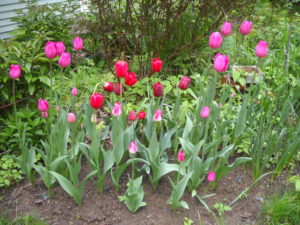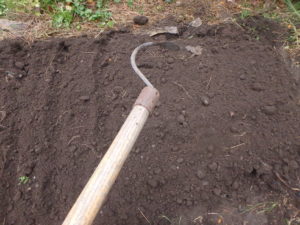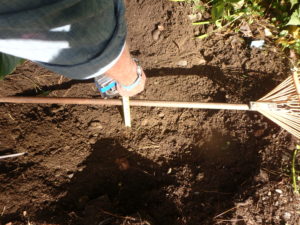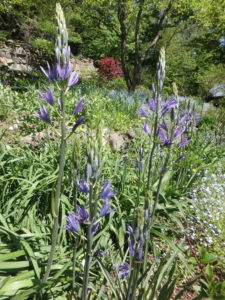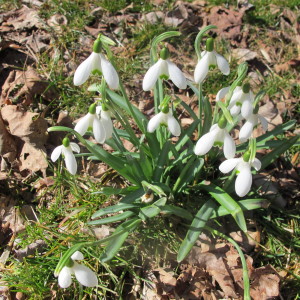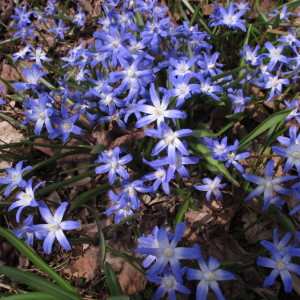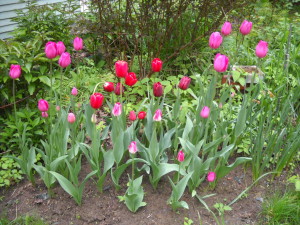It’s Time to Plant Bulbs for Spring Flowers
For decades I’ve been planting spring-flowering bulbs. Some come back every year, some disappear after a few years, and some I treat as annuals. The result? Just when mud season is about to swallow me whole, I am rewarded with flowers to enjoy outdoors – and indoors in a vase. Now is the time to plant bulbs.
First, some basics: All bulbs should bloom fine the first year. To come back, most need sunshine and well-drained soil. Most little bulbs will do fine in part shade.
I treat tulips as annuals, even in the best of circumstances. Not only that, squirrels will watch you plant them, and then get right to work digging them up as soon as you settle into a chair with a cup of tea. Deer will eat the blossoms, come spring. Daffodils are a better bet.
At the end of Bill Clinton’s term I got to interview the White House gardener, Dale Haney. He told me that they plant thousands of tulips each year on the White House grounds. I noticed lots of big, fat gray squirrels that seemed quite fearless, so I asked him how they kept them from eating the tulips.
The trick he said, is to plant masses together, and then spread chicken wire over the bed before you finish filling the hole with soil. Lay out the wire mesh an inch or two beneath the soil. That way a pesky squirrel will run into a barrier. And somehow, the tulip buds will find their way through the holes.
If you do that, and I have, make rectangular beds roughly the width of your chicken wire. I first tried a circular planting, and cut the chicken wire – which turns into something like razor wire when you cut it. I should have worn elbow-high leather gloves! I have decided it’s not worth the bother.
The other remedy Mr. Haney suggested, is to feed the squirrels. A fat squirrel is a lazy squirrel, he said, so feed them lots of corn. Your tax dollars do that at the White House. Huh.
Daffodils are generally long-lived. They are mildly poisonous, so rodents don’t eat them. And although daffodils will bloom in shady or half-shade places, they really do a whole lot better in full sun, with good drainage. No bulbs want to grow under pine trees or other evergreens.
The best way to plant bulbs is to dig a big hole and plant a lot of bulbs all at once. For daffodils or tulips, dig a hole 6 to 8 inches deep, 24 inches wide to 36 inches long. Have a wheelbarrow or tarp to place the soil on, so you don’t make a mess on the lawn to clean up.
Add an inch or more of compost, and then sprinkle some bulb booster or organic fertilizer in the bottom of the hole. Loosen the soil in the bottom of the hole with a hand tool, mixing the fertilizer and compost with the soil. Next, arrange the bulbs in the hole. Plant them pointy end up.
I like a mass of blossoms, so I plant bulbs close together. I read the directions for the bulb variety I am planting, and then plant them a little closer together. Pay attention to planting depth, too. Smaller bulbs like crocus need much less depth than big fat daffodils.
Most bulb plants reproduce by growing offsets, or little bulbs that develop alongside the mother bulb. After a year or two, the offsets will bloom, too, and you can dig up the bulbs and divide them after blooming if you want. I never have done that, but I remember my parents did when I was a boy.
What else should you try planting? Snowdrops bloom in early March for me, and are a must. Start with 50 bulbs – they are not very dramatic in a small clump. They do drop seeds and will show up downhill from where you plant them in a few years.
Glory-of-the-snow is nearly as early as snowdrops, but instead of white, these are purple or blue or even pink. And they look up, not down like snowdrops, so you can see their petals and interior better. Scilla, another favorite of mine, are a deep purple, and look down. Small, but intense.
Last year I planted several Camassia, a late-spring or early summer blooming bulb plant. They were wonderful! Each plant produces a few flower spikes that are 2 or 3 feet tall, and are covered with blue or purple florets. Very dramatic! They are hardy to Zone 4. Unlike most bulb plants, they do well in wet or moist soils in winter.
Alliums are in the onion family, are wonderful, and are not bothered by rodents. Some are huge, with balls nearly a foot wide that are airy and open, filled with little florets. The big ones can be expensive ($4 a bulb or more) but last a long time and are very dramatic. Even a half a dozen big ones will make a statement.
So get off the couch, get outside and plant some bulbs. Do so, and come spring you’ll be sending me an e-mail saying how glad you are that you did!
You may reach Henry by e-mail at henry.homeyer@comcast.net. He is the author of 4 gardening books and is a lifetime UNH Master Gardener.
Planting Bulbs
For the past 3 decades or more I‘ve planted the bulbs of spring-blooming plants every fall. Some years it was just a couple of dozen, other years more than 100. October is a good time to plant them, though one year I was traveling and didn’t plant my bulbs until November. I had to shovel snow off the ground to plant bulbs that year.
I plant bulbs because it gives me something to look forward to during the depths of winter. I dream of clouds of purple scilla and white snowdrops, hillsides awash with golden daffodils, vases of tulips on every flat surface of the house. For the price of dinner for two at a moderate restaurant, you can buy 100 bulbs or more – and now is the time to do so.
I love snow drops (Galanthus nivalis). Granted, they’re small and their blossoms hang down so they’re hard to see their faces well, but they’re the first to bloom, often coming up through frozen soil in early March. I transplanted fifty or a hundred from my childhood home in Connecticut 35 years ago, and by now I have uncountable numbers. They sneak into my lawn, popping up far from where I put them. I don’t know how they move around – perhaps by seed, or perhaps with the help of those otherwise pesky rodents, the squirrels.
Other early bloomers are scilla (Scilla siberica) and glory-of-the-snow (Chionodaxa spp.), both blue to purple (glory-of-the snow also comes in pink and white). Like snowdrops, they’re small – so they need to be planted in groups of 50 or more to really look good.
Crocuses also can bloom early, though I’ve never had any as early as my snowdrops. There are at least 80 species of crocus and many hundreds of colors, but most garden centers and grocery stores just offer a couple of species and three colors – large purple, white or yellow. For that reason I study the bulb catalogs to explore other possibilities.
The bulb company McClure and Zimmerman has an excellent array of crocus, but I find their website awkward, so it is probably worth calling for a print catalog (800-546-4053). Brent and Becky’s bulbs is a family run business that is also excellent (www.brentandbeckysbulbs.com or 804-693-3966). You may be surprised to see that crocus bulbs can cost over a dollar each, but the rarer varieties are pricey.
Daffodils are wonderful, in part, because animals don’t eat them, not rodents, not deer. There are hundreds of kinds of daffodils in 13 major categories. Some bloom early, some late. Some produce one flower per stem, others several. I continue to explore the daffodils each year by buying some new ones- and you should, too.
If you grow hostas, you know that their leaves don’t get very big until June or July. I like to plant clumps of daffodils between clumps of hosta so that their leaves will cover the foliage of the daffodils after they bloom.
In recent years I have been buying 100 tulips and planting them in one bed. I like them as cut flowers – and they make terrific gifts. I like having enough to pick dozens at a time, and having them all come into bloom at once.
Most tulips, for me, tend to run out of energy and get fewer in number as the years pass, so now I consider them annuals. I dig a hole about 4-5 feet long and 2 feet across and plant all 100 in one place. Then, once they are done, I cut off the foliage and plant annual cut flowers like zinnias for summer enjoyment. Wasteful? I suppose, but life is short, and I love them so.
I’ve found that my CobraHead weeder (www.CobraHead.com or 866-962-6272) works well for planting individual small bulbs like snowdrops or crocus in the lawn. I just push it into the soil the appropriate depth, pull back to create a small slice in the soil, take out the tool and drop in a bulb. The slice in the lawn closes up easily with a push of my hand.
My last bits of advice on planting bulbs: add some slow-release organic fertilizer (or bulb booster) at planting time, and mix plenty of compost into the soil. Bulbs need good drainage to thrive, and compost helps with that. If you are worried about rodents, you can sprinkle them with cayenne pepper, though its effect only lasts for a year.
Lastly, buy plenty of bulbs. Come spring, you’ll revel in their beauty and enjoy them much more than that ephemeral dinner for two you might skip now in order to afford their cost.
Read Henry’s blog about how to save your dahlia tubers for next year at https://dailyuv.com/news/



